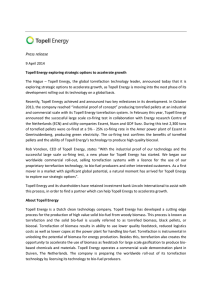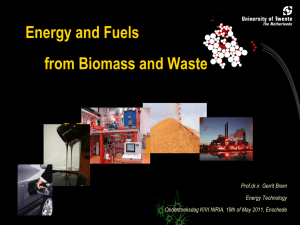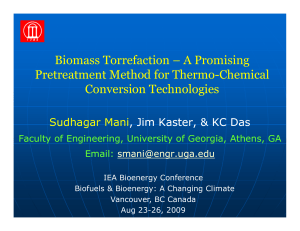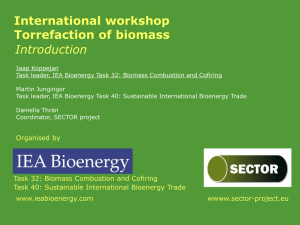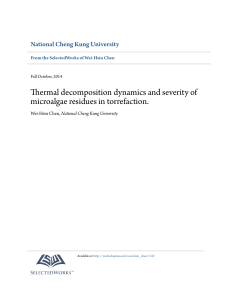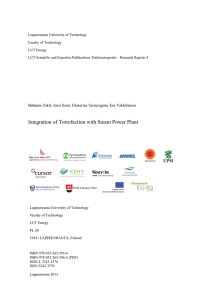bbb1624-sup-0001-AppendixS1
advertisement
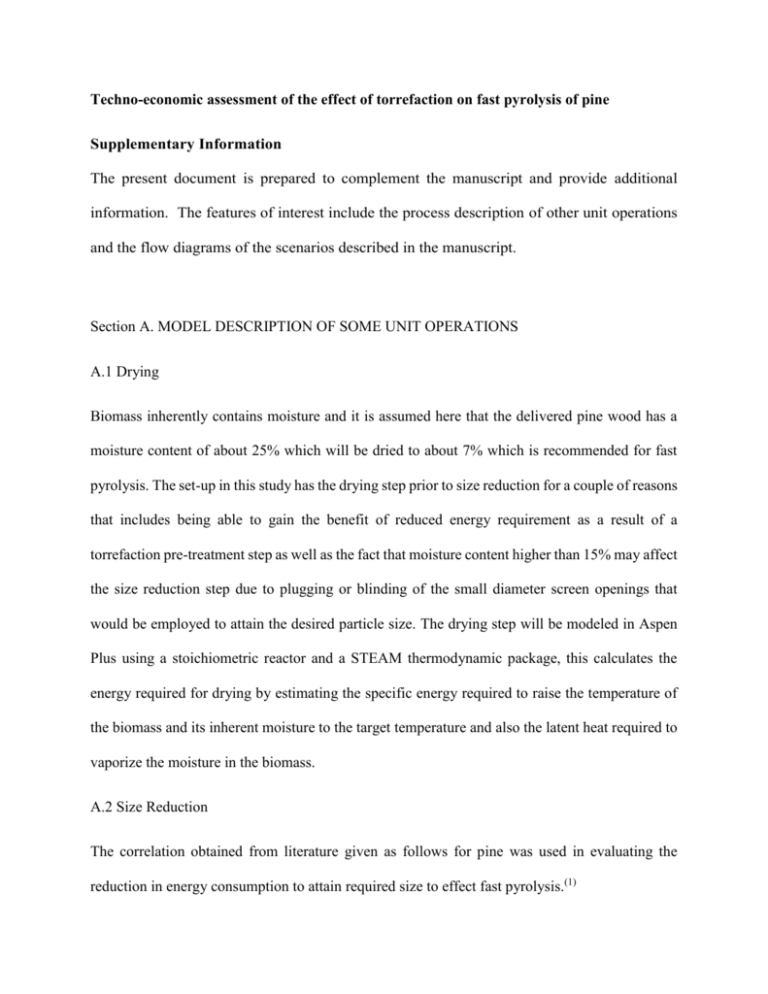
Techno-economic assessment of the effect of torrefaction on fast pyrolysis of pine Supplementary Information The present document is prepared to complement the manuscript and provide additional information. The features of interest include the process description of other unit operations and the flow diagrams of the scenarios described in the manuscript. Section A. MODEL DESCRIPTION OF SOME UNIT OPERATIONS A.1 Drying Biomass inherently contains moisture and it is assumed here that the delivered pine wood has a moisture content of about 25% which will be dried to about 7% which is recommended for fast pyrolysis. The set-up in this study has the drying step prior to size reduction for a couple of reasons that includes being able to gain the benefit of reduced energy requirement as a result of a torrefaction pre-treatment step as well as the fact that moisture content higher than 15% may affect the size reduction step due to plugging or blinding of the small diameter screen openings that would be employed to attain the desired particle size. The drying step will be modeled in Aspen Plus using a stoichiometric reactor and a STEAM thermodynamic package, this calculates the energy required for drying by estimating the specific energy required to raise the temperature of the biomass and its inherent moisture to the target temperature and also the latent heat required to vaporize the moisture in the biomass. A.2 Size Reduction The correlation obtained from literature given as follows for pine was used in evaluating the reduction in energy consumption to attain required size to effect fast pyrolysis.(1) 𝐸𝑔 = −0.756𝑇 + 260.0 (1) where Eg is specific energy consumption for grinding in kW-hr/ton, T is Temperature in oC The size reduction step was then modeled in Aspen Plus® as a hammer mill with the estimated specific energy consumed for grinding estimated at different torrefaction temperatures while the untreated raw pine’s energy was estimated using ambient temperature of 25oC. The work index required for grinding was also calculated using 𝐸𝑔 = 10 ∗ 𝑊𝑖 ∗ ( 1 √𝑃 − 1 √𝐹 ) (2) where Eg Specific energy consumption for grinding in kW-hr/ton, Wi is work index in kWhr/ton, P is final particle size in microns and F is Initial particle size in microns A.3 Combustion Combustion of products when considered in this study was not modeled using the process simulation software, however the heat released during combustion were estimated from correlations obtained from literature as shown below: A.3.1 Combustion of char Heat released from the combustion of char was evaluated based on the lower heating value of char, which was estimated from its higher heating value based on correlation from literature given below:(2) 𝑤 𝑤 ℎ 𝐿𝐻𝑉 = 𝐻𝐻𝑉 (1 − 100) − 2.444 ∗ 100 − 2.444 ∗ 100 ∗ 8.936 (1 − Where 𝑤 𝑀𝐽 ) [ 𝑘𝑔 , 𝑤. 𝑏. ] 100 (3) 2.444 = enthalpy difference between gaseous and liquid water at 25oC 8.936 = MH2O/MH2; i.e. the molecular mass ratio between H2O and H2 LHV = lower heating value HHV = higher heating value w = moisture content of the fuel in wt% (w.b.) h = concentration of hydrogen in wt% (d.b.) The higher value utilized in equation above was also estimated from empirical formula as well as shown below.(3) 𝑀𝐽 𝐻𝐻𝑉 = 0.3491𝑋𝐶 + 1.1783𝑋𝐻 + 0.1005𝑋𝑆 − 0.0151𝑋𝑁 − 0.1034𝑋𝑂 − 0.0211𝑋𝑎𝑠ℎ [ 𝑘𝑔 , 𝑑. 𝑏. ] (4) Where Xi is the content of carbon (C), hydrogen (H), etc. from the ultimate analysis of the solid fuel. A.3.2 Combustion of condensates from torrefaction Energy released from the combustion of condensates from torrefaction when such step takes place in this study was estimated by obtaining from literature the lower heating value of the individual components in the condensates.(4) Based on the lower heating value of the individual components and their weight fraction in the liquid, the lower heating value of the liquid was estimated. For high molecular compounds produced from either the torrefaction or pyrolysis step whose lower heating values were not found in literature, their lower heating values were estimated using correlation obtained from literature as shown below:(5) For compounds containing only carbon, hydrogen and oxygen, general combustion reaction was given as 𝐶𝑎 𝐻𝑏 𝑂𝑐 + (𝑎 + 𝑏 𝑐 𝑏 − ) 𝑂2 → 𝑎𝐶𝑂2 (𝑔) + 𝐻2 𝑂 (𝑙) 4 2 2 (5) The standard heat of combustion is then given as ∆𝑐 𝐻 ° = −𝑎∆𝑓 𝐻 ° (𝐶𝑂2 , 𝑔) − 1 2 𝑏∆𝑓 𝐻 ° (𝐻2 𝑂, 𝑙) + ∆𝑓 𝐻 ° (𝐶𝑎 𝐻𝑏 𝑂𝑐 ) = 393.51𝑎 + 142.915𝑏 + ∆𝑓 𝐻 ° (𝐶𝑎 𝐻𝑏 𝑂𝑐 ) (6) (7) Where ∆𝑓 𝐻 ° is the enthalpy of formation. When the heat of formation is not available from literature, it was estimated based on the structure of the component by using the Joback method which is based on group contribution.(4, 6) A.3.3 Combustion of non-condensable gas from torrefaction Heat generated from combustion of non-condensable gas from torrefaction was estimated using the lower heating value of the components present in the non-condensable gas phase. Severity of torrefaction usually determines the components contained in the non-condensable gas, however for this study, the components were assumed to be essentially CO2 and CO in a 80 to 20 ratio hence heat released from combustion is due to the CO component only, this assumption is supported by the report of Tumuluru et al which showed energy released from the combustion of volatiles from torrefaction is mainly from CO.(7) A.3.4 Bioe correlation for heat of combustion estimation One of the correlation used in Aspen Plus® to estimate the heat of combustion of unconventional solids such as biomass based on the ultimate analysis is as shown: 𝑑𝑚 𝑑𝑚 𝑑𝑚 𝑑𝑚 𝑑𝑚 ∆𝑐 ℎ𝑖𝑑𝑚 = [𝑎1𝑖 𝑤𝐶,𝑖 + 𝑎2𝑖 𝑤𝐻,𝑖 + 𝑎3𝑖 𝑤𝑆,𝑖 + 𝑎4𝑖 𝑤𝑂,𝑖 + 𝑎5𝑖 𝑤𝑁,𝑖 ]102 + 𝑎6𝑖 (8) Where wC,i dm is the weight fraction of carbon. Values of the parameters as given by Aspen Plu® are as follows(8) a1i = 151.2, a2i = 499.77, a3i = 45.0, a4i = -47.7, a5i = 27.0 and a6i = -189 A.4 Conveyance Biomass movement across the plant is assumed to be carried out using conveyor belts, and the energy required for this conveyance was estimated by firstly using the guidelines by CEMA as shown by Couper et al.(9, 10) The conveyance is assumed to be carried out using a 24 inch, 45o troughed belt conveyor of length, 33.5m and up a longitudinal incline of 22o. The running angle of repose of the woodchips is taken to be about 30o and the required power is estimated by using equation 7. 𝑃𝑜𝑤𝑒𝑟 (ℎ𝑝) = 𝑃ℎ𝑜𝑟𝑖𝑧𝑜𝑛𝑡𝑎𝑙 + 𝑃𝑣𝑒𝑟𝑡𝑖𝑐𝑎𝑙 + 𝑃𝑒𝑚𝑝𝑡𝑦 (9) Where Phorizontal = (0.4+L/300)(W/100), Pvertical = 0.001HW, and Pempty obtained based on desired conveyor length from literature.(10) A.5 Energy Return on Energy Invested (EROEI) 𝐸𝑅𝑂𝐸𝐼 = 𝐸𝑛𝑒𝑟𝑔𝑦𝑜𝑢𝑡 𝐸𝑛𝑒𝑟𝑔𝑦𝑖𝑛 =𝐸 𝐸𝑏𝑜 + 𝐸𝑐ℎ𝑎𝑟 𝑡ℎ𝑒𝑟𝑚𝑎𝑙 +𝐸𝑒𝑙𝑒𝑡𝑟𝑖𝑐𝑖𝑡𝑦 = 𝑚̇𝑏𝑜 𝐿𝐻𝑉𝑏𝑜 +𝑚̇𝑐ℎ𝑎𝑟 𝐿𝐻𝑉𝑐ℎ𝑎𝑟 𝐸𝑡ℎ𝑒𝑟𝑚𝑎𝑙 +𝐸𝑒𝑙𝑒𝑐𝑡𝑟𝑖𝑐𝑖𝑡𝑦 (10) Where Ebo is the energy obtainable from bio-oil estimated based on its lower heating value (LHV), Echar is the energy obtainable from char also obtained from its lower heating value. 𝑚̇ is the mass flowrate while Ethermal is the required process heat required over the whole process and Eelectricity is the energy associated with size reduction and conveyance across the process. Energy due to electricity was converted to thermal assuming an efficiency of about 35% for the conversion of steam to electricity. SECTION B. INPUT DATA TABLES USED IN MODELING Table 1a. Torrefation component distribution (wt % organics) of organics from torrefaction of pine at different torrefaction temperatures. Component (wt/wt organics) Acetic Acid Propionic Acid Acetol Fufural 2-Furanmethanol 5-(hydroxymethyl)-2-furancarboxaldehyde Levoglucosan Xylose Hydrolysable Oligomers(cellobiose) Glucose Isoeugenol Eugenol Vanillin 2-methoxy-4-vinylphenol(p-vinylguaiacol) Catechol(benze-1,2-diol) Phenol 2-methoxyphenol (guaiacol) 4-methylphenol(p-cresol) 3-methylphenol (m-cresol) 4-ethylphenol 2-methoxy-4-methylphenol (creosol) Low MW Lignin Derived Compound A(Dimethoxy stilbenzene) Low MW Lignin Derived Compound B (Dibenzofuran) High MW Lignin Derived Compound A High MW Lignin Derived Compound B 290oC 8.01 0.25 2.47 1.01 0.09 0.00 0.40 0.40 0.00 0.10 0.33 0.05 0.21 0.00 0.00 0.00 0.49 0.00 0.00 0.00 0.00 0.95 Torrefaction temperature 310oC 330oC 11.92 13.09 0.42 0.48 5.08 6.43 1.26 1.95 0.11 0.21 0.00 0.00 2.43 3.00 1.22 1.32 0.15 0.36 0.61 0.60 0.76 1.83 0.13 0.27 0.32 0.31 0.00 0.00 0.00 0.00 0.00 0.00 0.83 1.48 0.00 0.00 0.00 0.00 0.00 0.00 0.00 0.00 1.24 1.87 0.19 0.25 0.38 0.79 0.17 1.04 0.23 1.56 0.34 Table 2a. Ultimate analysis data (wt %) for torrefied pine chips at different torrefaction temperatures. Torrefaction Temperature Component Ash Carbon Hydrogen Chlorine Nitrogen Sulfur Oxygen 290oC 0.6 55.05 5.94 0.11 38.3 310oC Wt % 0.6 57.27 5.79 0.14 36.0 330oC 0.8 65.75 4.87 0.28 27.6 Table 3a. Proximate analysis data (wt %) for torrefied pine chips at different torrefaction temperatures. Torrefaction Temperature Component Ash Moisture Content Volatile Matter Fixed Carbon 290oC 0.60 0 78.6 20.8 310oC Wt % 0.80 0 76.4 22.8 330oC 1.4 0 60 38.6 Table 4a. Pyrolysis component distribution of organics (wt/wt organics) for one step and two step pyrolysis of pine. One Step Component Two Step 290oC 310oC 330oC 7.59 3.69 3.11 1.00 0.12 0.23 4.42 0.00 3.28 0.29 0.07 0.28 2.96 0.00 2.39 0.15 0.04 0.15 1.11 0.00 0.85 0.38 0.11 0.45 7.24 2.19 3.29 1.10 0.54 0.12 0.42 0.79 2.53 0.19 0.46 0.06 0.02 0.07 0.46 7.11 7.91 2.05 5.28 1.17 0.58 0.36 0.14 0.37 4.88 0.33 0.46 0.12 0.06 0.14 0.85 6.50 6.04 1.01 4.70 0.34 0.58 0.20 0.15 0.25 2.32 0.24 0.37 0.10 0.13 0.05 0.50 6.00 8.45 0.94 0.00 0.00 0.50 0.17 0.12 0.21 2.08 0.23 0.30 0.06 0.09 0.07 0.59 3.05 1.43 1.31 1.21 0.62 5.94 1.30 5.43 1.18 5.02 1.10 2.55 0.56 Torrefaction temperature (wt %) Acetic Acid Propionic Acid Acetol Fufural 2-Furanmethanol 5-(hydroxymethyl)-2furancarboxaldehyde Levoglucosan Xylose Cellobiose Glucose Isoeugenol Eugenol Vanillin P-vinylguaiacol Catechol Phenol Guaiacol P-cresol M-cresol 4-ethylphenol Creosol Low MW Lignin Derived Compound A(Dimethoxy stilbenzene) Low MW Lignin Derived Compound B (Dibenzofuran) High MW Lignin Derived Compound A High MW Lignin Derived Compound B Table 5a. Ultimate and proximate data (wt %) for char obtained after pyrolysis. Ultimate Analysis Components Wt. % Ash 7.67 Carbon 83.03 Hydrogen 1.14 Nitrogen 1.37 Chlorine Sulfur Oxygen 6.56 Proximate Analysis Components Wt. % Ash 4.60 Moisture Content Volatile matter 7.40 Fixed carbon 88.0 Table 6a. Estimated number of employees and their wages rate. Employee Plant/General Manager Plant Engineer Maintenance Supervisor Lab Manager/Chemist Shift Supervisor Maintenance Tech Shift Operators Admin Assistants Annual Salary Number Required $136,830.00 1 $108,630.00 1 $76,480.00 1 $77,970.00 1 $74,470.00 5 $70,450.00 6 $55,980.00 23 $43,440.00 2 SECTION C. SCHEMATIC DIAGRAMS FOR SCENARIOS 2 & 3 OF THE DESIGN OBJECTIVES. Non condensable gases 1 Combustion of gas to offset natural gas usage Torrefaction at temperatures of 290oC , 310oC and 330oC Conveyor feed hopper Woody biomass chips, 25mm 25% MC Woody biomass chips, 25mm 8% MC Conveyor Dryer Non condensable gases 2 Torrefier Torrefier feed hopper Conveyor Bio-oil condenser Biocoal chips, 25mm Bio-Oil Hammer mill Cyclone Condensed liquid from torrefaction added to liquid from pyrolysis Combustion of char to offset natural gas Pyrolysis unit feed hopper Biocoal chips, 2mm Biochar Fast Pyrolysis Unit Conveyor Figure c1. Schematic diagram for scenario 2 of a two-step conversion route. Non condensable gases 1 Combustion of gas to offset natural gas usage Torrefaction at temperatures of 290oC , 310oC and 330oC Conveyor feed hopper Woody biomass chips, 25mm 25% MC Conveyor Dryer Non condensable gases 2 Woody biomass chips, 25mm 8% MC Torrefier Torrefier feed hopper Conveyor Bio-oil condenser Biocoal chips, 25mm Bio-Oil Hammer mill Cyclone Combustion of some of the liquid from torrefaction Credits for char sales Pyrolysis unit feed hopper Biocoal chips, 2mm Biochar Fast Pyrolysis Unit Conveyor Figure c2. Schematic diagram for scenario 3 of a two-step conversion route for pine biomass to bio-oil. SECTION D. FIGURES FOR SENSITIVITY ANALYSIS RESULTS. Figure d1. Sensitivity analysis for scenario 2 of a one-step conversion of pine to bio-oil Figure d2. Sensitivity analysis for scenario 1 of a two-step conversion process of pine to bio-oil at torrefaction temperature of 290oC. Figure d3. Sensitivity analysis for scenario 2 of a two-step conversion process of pine to bio-oil at torrefaction temperature of 290oC. Figure d4. Sensitivity analysis for scenario 3 of a two-step conversion process of pine to bio-oil at torrefaction temperature of 290oC. Figure d5. Sensitivity analysis for scenario 1 of a two-step conversion process of pine to bio-oil at torrefaction temperature of 310oC. Figure d6. Sensitivity analysis for scenario 2 of a two-step conversion process of pine to bio-oil at torrefaction temperature of 310oC. Figure d7. Sensitivity analysis for scenario 3 of a two-step conversion process of pine to bio-oil at torrefaction temperature of 310oC. Figure d81. Sensitivity analysis for scenario 1 of a two-step conversion process of pine to bio-oil at torrefaction temperature of 330oC. Figure d9. Sensitivity analysis for scenario 2 of a two-step conversion process of pine to bio-oil at torrefaction temperature of 330oC. Figure d10. Sensitivity analysis for scenario 3 of a two-step conversion process of pine to bio-oil at torrefaction temperature of 330oC. References 1. Phanphanich M, Mani S. Impact of torrefaction on the grindability and fuel characteristics of forest biomass. Bioresource technology. 2011;102(2):1246-53. 2. Koppejan J, Van Loo S. The handbook of biomass combustion and co-firing: Routledge; 2012. 3. Gaur S, Reed TB. An atlas of thermal data for biomass and other fuels. National Renewable Energy Lab., Golden, CO (United States), 1995. 4. Perry RH, Green DW, Maloney JO, Abbott MM, Ambler CM, Amero RC. Perry's chemical engineers' handbook: McGraw-hill New York; 1997. 5. Haynes WM. CRC handbook of chemistry and physics: CRC press; 2013. 6. Joback KG, Reid RC. Estimation of pure-component properties from group-contributions. Chemical Engineering Communications. 1987;57(1-6):233-43. 7. Shankar Tumuluru J, Sokhansanj S, Hess JR, Wright CT, Boardman RD. REVIEW: A review on biomass torrefaction process and product properties for energy applications. Industrial Biotechnology. 2011;7(5):384-401. 8. Plus A. Aspen Technology. Inc, version. 2009;11. 9. Conference CEMAE. Belt conveyors for bulk materials: Conveyor Equipment Manufacturers Association; 1997. 10. Couper JR, Penney WR, Fair JR. Chemical Process Equipment revised 2E: Selection and Design: Gulf Professional Publishing; 2009.
